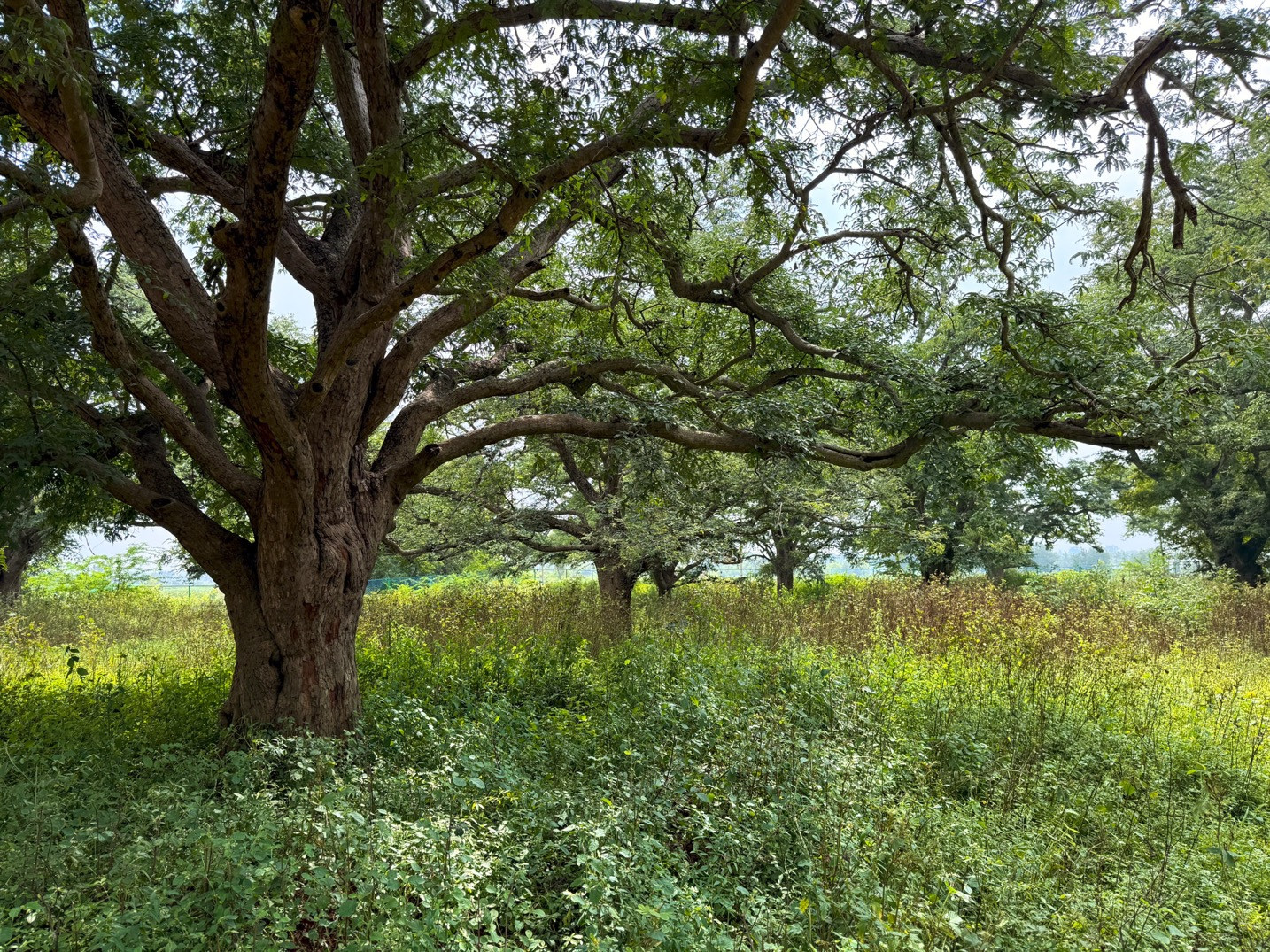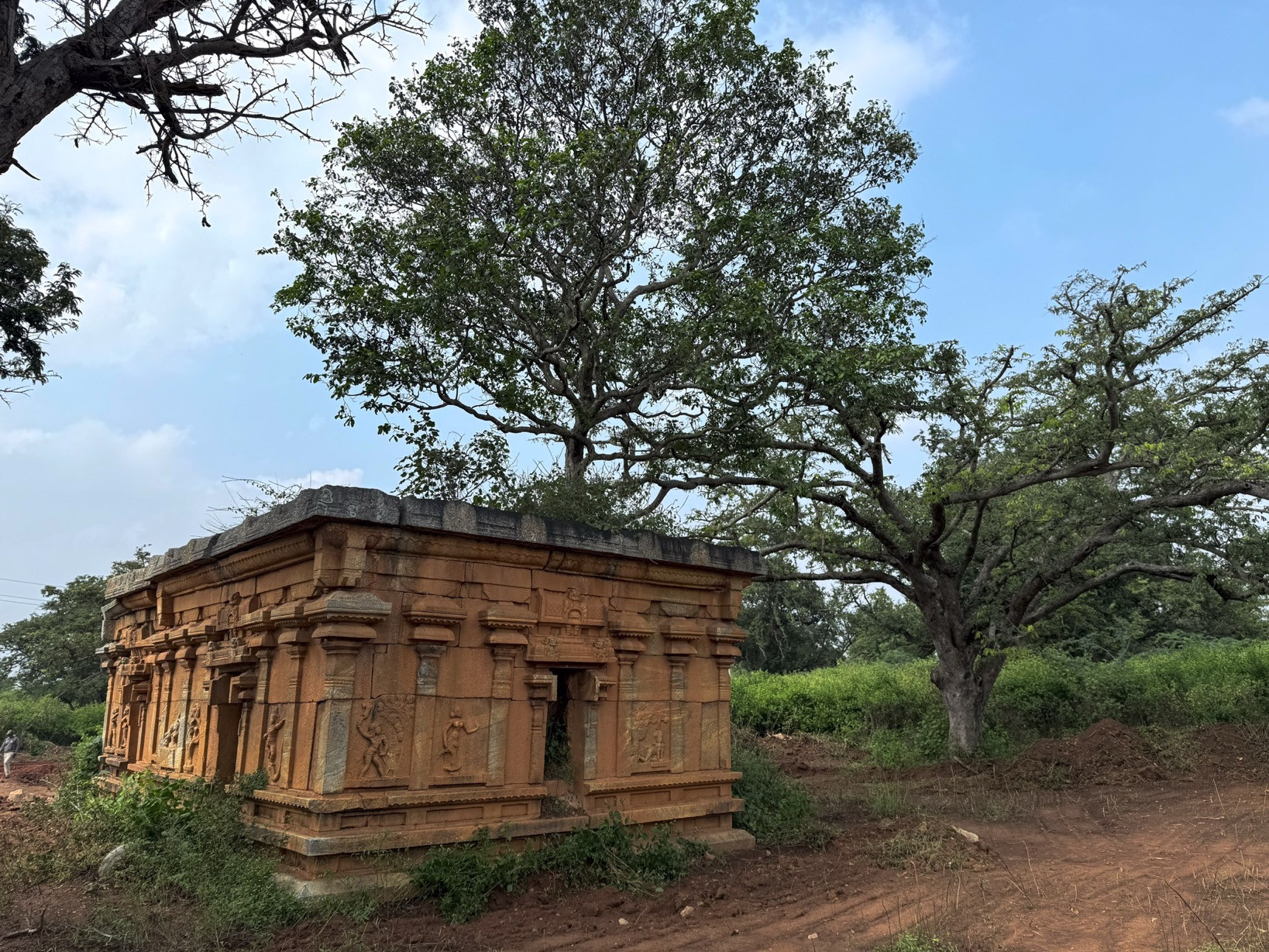As soon as you enter the tamarind grove at Nallur, the roar of aeroplanes landing and taking off recedes into the background, and the grind of traffic on the nearby road is almost magically quietened. A calming stillness envelops you. You hear the whirring, trilling and twittering of birds and insects. A squirrel skitters into the bushes as you walk. A grasshopper flits across your face and settles on a leaf nearby.
Tamarind trees dot the entire landscape here, almost to the exclusion of other species. There are a few saplings and some young growth, but even the most untrained eye can see that most of the mature trees are old tamarinds. Though a majority of the trees are not tall, some of them are of such huge girth that it would take more than two people to hug them properly. Others have large hollows and what a signboard at the heritage site describes as “artistic warty markings.” Several are gnarled, twisted and calloused like weatherbeaten ancients that have been ravaged by time - and a very long time at that.
Amazing antiquity
In 2008, a team of scientists from GKVK University of Agricultural Sciences, Bangalore, studied these unusual trees. Based on appearance, they categorised them into old, middle-aged and young. They then took wood samples from all 18 of the ‘old’ trees to determine their age through carbon dating. The oldest of these was found to be 410 years old. Considering that tamarind trees usually have a maximum lifespan in the range of 200 years, this is remarkable. Most of the other trees they sampled were around 200 years, while one was a mere stripling of 84 years.
My mind kept returning to that remarkable figure - about 410-years-old in 2008. That meant someone had planted the seed back in about 1598, when the Mughal emperor Akbar was still on his throne. Perhaps, it had even not been planted intentionally. Nandini Ramesh was one of the three scientists who first studied the tamarind grove. She believes Nallur’s sacred grove was not manmade. Ramesh, now a professor and head of the Small Millets Programme at GKVK, has also been studying other unusual aspects of this grove of trees. “There is a lot of variability in etiology, biochemistry and phenology,” she says. For instance, she and her colleagues found a lot of variation in the 14 phenological traits (biological life cycles) that they studied, such as the colour of the pods and leaves, the shape of the crown, seed number, seed weight, and so on. “Such variation suggests the seeds were not all planted together from one source,” she reasons.
However, we do know that at least some of the trees were indeed planted. In their book Cities and Canopies, ecologists Harini Nagendra and Seema Mundoli note that back in the late 1800s, the British government had appointed watchers to protect the Nallur Grove, and also planted additional trees here. A census in 1887 recorded 55 big and 342 large tamarind trees here. Today, the protected grove has approximately 278 tamarind trees. There are also several large tamarind trees outside the site, in and around the village.
Apart from their great age, another curious feature of some of Nallur tamarinds is what look like prop roots and accessory trunks. No, the tamarinds are not morphing into Ficus. In fact, these are the result of meristematic tissue forming at wounds, some of which then produces roots and shoots that grow to become clones of the mother plant. Although tamarind is strongly cross-pollinated, the trees here also show vegetative reproduction.
As would be expected, the tamarind grove harbours lots of other life. Small mammals like jackal, pangolin, black-naped hare and slender loris are found here. Owls favour the smaller hollows that the trees offer. A 2008 survey found that at least seven different species of owls roost and breed in the grove. Besides the owls, there were 76 different species of birds spotted here.
A temple within
The grove also shelters heritage of a different kind. In a clearing inside lie the ruins of a small temple, popularly called the Chennakeshava temple. A tree grows through what was once the temple’s roof. The sanctum is a mass of fallen stones. Only a portion of the temple walls still stand, their red-hued granite a brilliant contrast to the green and brown backdrop of the grove.
Even in its ruined state, the shrine is mesmerising. Superbly executed sculptures decorate the outer wall, most of them of the god Krishna. A playful Krishna eating butter; an adorably penitent Krishna, looking guilty and cheeky at the same time; Krishna crawling and pulling a mortar between two trees; sitting gleefully atop a tree while young women below beseech him to return their clothes; dancing on Kaliya the serpent, and so on. The carvings are lively, fluid and filled with detail, and you recognise at once that they are the work of a master artist of yore.
For more information on the temple, I turned to the trusty Epigraphia Carnatica, a 13-volume compendium of inscriptions in Karnataka. Two inscriptions were found at a Rama temple in Nallur, dating from the late 14th and early 15th century. Both mention a temple to the god Tirumalenatha. Would this Krishna temple date from the same period? Art historian Sarada Natarajan of Azim Premji University believes the temple is older. “Based on the stylistic evidence of architectural articulation and motifs, I believe the temple was built in the late 13th or early 14th century,” she says. This would date the temple to some decades after the Chola dynasty had ceased to be. Natarajan says there was probably an agrahara or Brahmin settlement associated with the temple. Today of course, the temple is ensconced in the grove and there is no trace of any old settlement nearby.
Local lore
The village of Nallur Kote, meaning Nallur Fort, is a few hundred metres away from the grove. “There used to be old mud bricks that were part of the fort walls when we played there as children,” says 68-year-old Gowdaru Munibhyrappa, a local resident, who started chatting about the Nallur Grove and temple while we sat sipping chai at a tea shop.
He then narrated an oft-told story about the origin of the grove. Long ago, the daughter of the ruling chieftain of Nallur wished to marry a young man who was from Devanahalli, Gubbi, or Dalikote (depending on the storyteller), but her father was against this alliance. Defying him, the princess and her mother hatched a plot to make the marriage happen. The princess told her paramour about a spring which was Nallur’s main source of water, and he managed to block it, or perhaps used it to enter the fort. A battle ensued, but not before the astute chieftain buried his treasure and scattered tamarind seeds to mark the spot. And thence came about the Nallur Grove, says the legend. Munibhyrappa and his companions at the tea shop then offered us a more mundane origin for the grove. The seeds could be part of the waste discarded by people who used to visit the Gangadevi temple nearby for special feasts, they said.
I was curious to learn more about the relationship between the local people and the grove. The grove was earlier used by farmers to graze their goats and cattle, while the seed crop was auctioned every year to contractors. These activities have been stopped for the last three years, “so that animals and birds can have the seeds,” said one resident. Snakes and other dangers also act as a deterrent for people to enter.
There had been attempts to restore the Chennakeshava temple, but it did not happen, the locals asserted gravely. Manjunath, the owner of the tea shop, described finding granite slabs that were about 6 feet high, placed in a square and with another large slab covering it. “These are full of ash, the whole place is full of ash,” added Munibhyrappa. I felt a frisson of excitement. Their descriptions matched megalithic burials called cists that are found in several places in the Devanahalli region, which are anywhere from 2,000 to 3,000 years old. But of course, it would have to be explored and established scientifically. Nallur’s tamarind grove dates from the 17th century and its temple possibly dates from the late 13th century. It is just possible that underneath it all, there are remnants of a past that is far, far older.
Edited by Sheema Mookherjee










